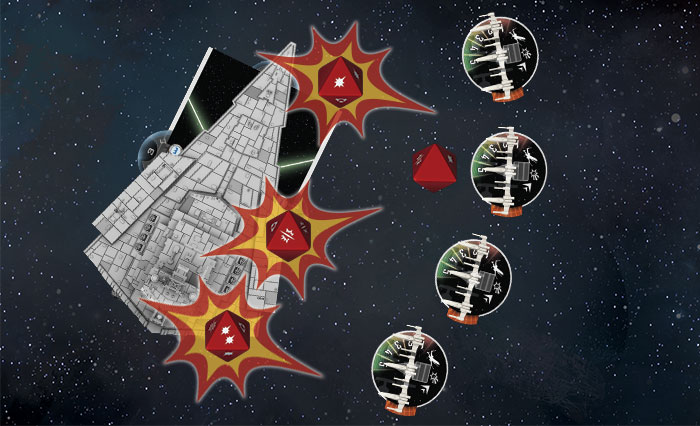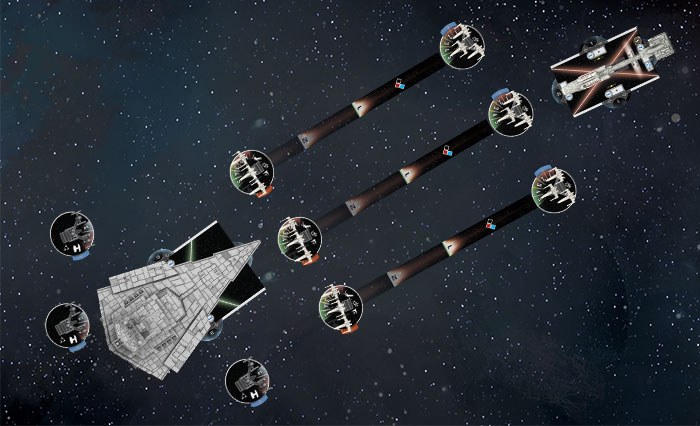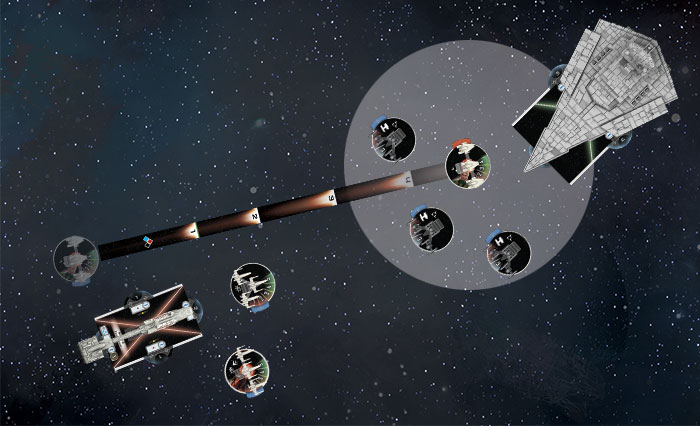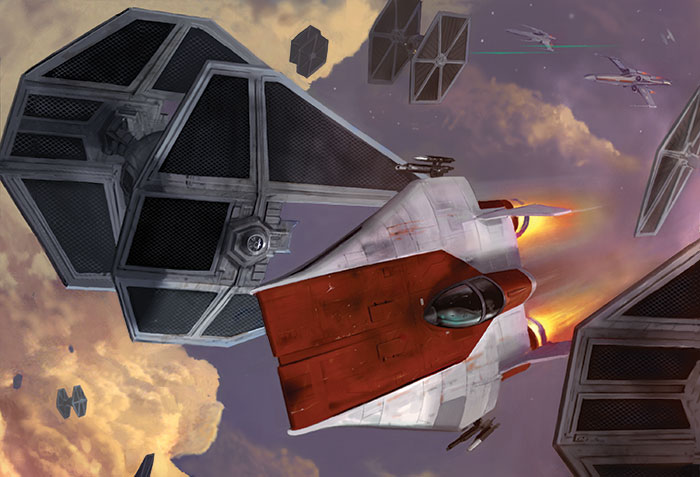Post by Fadril Adren on Mar 22, 2016 16:57:25 GMT -5


Developer Max Brooke on Winning Your Squadron Battles
As a game of capital ship battles, Star Wars: Armada focuses on titanic clashes between behemoths in the depths of space, surrounded by clouds of screaming starfighters. However, the deadly duels between those squadrons of starfighers also comprise a small, but important part of the battles that Armada emulates.
Although, it's technically possible to launch a fleet without squadrons, I wouldn’t leave home without at least a small defensive force. Remember, on top of the raw damage that uncontested bomber squadrons can inflict, a capital ship’s most important protective resources – its defense tokens – are substantially less effective against the numerous, small hits that squadrons inflict.

Evade tokens are usually useless against squadrons’ close-up attacks, and even the redoubtable Brace token that halves the damage from a single attack is little consolation against five separate hits for one to two damage each. Whether you send them on the offensive or use them exclusively to defend, squadrons play an important role in a balanced fleet.
Although squadron composition is a complex problem, it starts with one simple question: Do you want your squadrons to focus primarily on sinking enemy capital ships or on preventing enemy squadrons from destroying your own capital ships? Knowing the main role you want your squadrons to play can help you tailor your choices to serve that strategy, and decide whether you want to construct a bomber wing or a fighter screen.
Bomber Wings
If you want your squadrons to focus on dealing damage to enemy ships, you’ll want to construct a bomber wing. Typically, this means including a group of squadrons that possess the Bomber keyword, which allows them to inflict critical hits on capital ships, plus some other squadrons to help them carry out their deadly mission. If you take a bomber wing, you’re committing to inflicting some damage on enemy capital ships with these bombers. You’ll still be relying on your capital ships to do some damage to enemy capital ships, but you’ll also need to spend multiple commands getting your squadrons into position to strike.
The fleet-building rules limit the construction of your bomber wing to no more than one-third of your total fleet points, but that still leaves room for a lot of different compositions. Nonetheless, there are a few squadrons that stand out for use in bomber wings. For the Rebels, Y-wing Squadrons and B-wing Squadrons are the most reliable bomber options, though X-wing Squadrons can also work.

The Rebel squadrons with the Bomber keyword: B-wing, Y-wing, and X-wing.
For the Imperial side, TIE Bomber Squadrons are the best anti-ship option by far. TIE Advanced Squadrons lack Bomber, but they can still inflict some damage with one black die for their anti-ship attack, which becomes even more effective when you use their considerable speed to reach vulnerable hull zones.
In order to pose a credible threat to your opponent's capital ships, you'll need your bomber wing to number several squadrons. In games of 300 fleet points, it's fairly reasonable to purchase sixty to seventy-five points of bombers. Aces are an appealing option, especially Keyan Farlander and Major Rhymer , but make sure you still have enough standard bombers to get the job done. Of course, you also need to make sure that your bombers survive long enough to get their job done, and this is where your choices get more complex. Flying tough squadrons with the Escort keyword alongside your bombers not only makes them much harder to kill, but also help them punch through fighter screens in time to fire at enemy ships. Darth Vader and Luke Skywalker are obvious choices as escorts for a bomber wing, as both are nearly as deadly against capital ships as they are against other squadrons, but Soontir Fel can also perform admirably in this role, shredding any fighters who ignore him to attack your TIE Bomber Squadrons.
A basic bomber wing might look like this:

* Major Rhymer (16)
* TIE Bomber Squadron (9)
* TIE Bomber Squadron (9)
* TIE Bomber Squadron (9)
* TIE Advanced Squadron (12)
* TIE Advanced Squadron (12)
Total Fleet Points: 67
At sixty-seven of your 300 fleet points, this bomber wing constitutes a substantial investment, but not so much that it seriously limits your options for capital ships and upgrades. Still, you’ll be relying on it to deal some real damage, so you may consider upgrading your fleet with Expanded Hangar Bay and Admiral Chiraneau to lend more effective support to your bombers. In battle, you’ll want to use this bomber wing’s high speed and the expanded range that Major Rhymer grants it to dart in, smash an unprotected enemy capital ship, and then move on to another target before your foes can pin it down.
Fighter Screens
On the other hand, a fighter screen consists of squadrons designed to intercept enemy squadrons, engage them, and keep your capital ships safe. Fighter screens aren't meant to inflict major damage on enemy ships, so if you take a fighter screen to battle, you're going to need your capital ships to win their exchanges with enemy ships. As for your fighters, they need to balance killing power with mobility, and you want to do this as economically as possible in order to keep the focus on your capital ships. At 300 fleet points, it makes sense to commit anywhere from twenty-four to fifty points to your fighter screen.
The goal is to engage enemy bombers, and while destroying enemy squadrons can be a good way to earn victory points, your fighters don't need to destroy enemy fighters so long as they keep your ships from suffering bomber damage. Squadrons with a high speed rating can be key, here, as your squadrons must be able to either pounce on enemy squadrons before they attack or rapidly get into position to ward off enemy bombing runs entirely.
Imperial players will find that a swarm of TIE Fighter Squadrons and TIE Interceptor Squadrons will serve as a great fighter screen. On the Rebel side, A-wing Squadrons pair their tremendous speed with the Counter ability, which lets them menace any enemy fighter squadrons who might attack them. X-wing Squadrons can work well in this role too, though, as they are tougher than A-wings and hit harder when they attack. Additionally, ace pilots really shine in fighter screens; the extra durability their defense tokens gives them makes them that much better at pinning down enemy forces for multiple rounds, and many have some truly lethal anti-squadron abilities. Tycho Celchu , Wedge Antilles , "Howlrunner," and "Mauler" Mithel all stand out as great choices to lead a fighter screen.
A basic fighter screen might look like this:

* Tycho Celchu (16)
* A-wing Squadron (11)
* A-wing Squadron (11)
* A-wing Squadron (11)
Total Fleet Points: 49
A force like this gives you a lot of flexibility, thanks to its speed and the Counter ability. It can lurk behind your ships and wait for enemies to come within its astounding striking range. Alternatively, it can zoom out to position in front of your ships, daring enemies to launch the first strike, or even split into two pairs to cover multiple angles of attack. Even if they strike with their escorts in order to pin down your squadrons, leaving their bombers free, Tycho’s special ability leaves him leave free to chase the bombers. Position denial tactics can be especially effective against Major Rhymer and his cohort, provided that you can guess where your opponent wants to send them.
Getting the Most from Your Squadrons
Of course, no plan survives contact with the enemy. Squadron strategy might start during list-building, but it certainly does not end there. Deploying your fighter squadrons properly is also very important, as is carefully plotting your squadron commands and maneuvering your ships to keep them within medium range of your squadrons when the time comes to issue those commands.
Squadrons can deploy anywhere within Distance "2" of one of your capital ships, which means that they can go behind your ships, alongside them, or even in front of them, further toward the center of the battlefield than your ships can deploy. However, as you deploy your squadrons, you want to keep a few factors in mind, such as which squadrons your opponent is fielding, who has initiative, and the overall board setup.

Your fighter squadrons can deploy anywhere within Range "2" of your ships… which means they can even deploy outside of the deployment zone in order to pounce upon your opponent's ships and squadrons.
Perhaps the most important question at this stage is which squadrons your opponent is fielding.
* If your opponent is heavy on bombers, you need to consider how to counter them – or if your own squadron complement is mostly bombers, you may simply want to ignore them and instead start in a race to destroy capital ships.
* If your opponent is running mostly anti-fighter squadrons and you have a core of bombers, you must decide if you want to try to outmaneuver their screen, break through it, or split your forces to pin the screen down elsewhere while your bombers attack.
*If both of you brought fighter screens, you can try to win the fighter battle for the victory points it yields or, if you find your starfighters outclassed or outnumbered, you might want to try to have your squadrons fight conservatively, so as not to give up victory points to the enemy.
Meanwhile, the farther in front of your ships your squadrons are deployed, the sooner your enemy is going to be able to engage them. Thus, deploying in front of your capital ships is a risky move for a bomber wing, but it can pay out, especially if you have initiative and can launch your bombers directly into the thick of their fleet within the first few turns. When you’re using a fighter screen, placing your squadrons ahead of your capital ships can force your opponent to make a hard choice – fly directly into your defenders and hope to break through, or wait and try to maneuver around.

Position denial can be just as effective a means to protect your capital ships from bombers as destroying those bombers. This tactic is especially effective with A-wings and TIE interceptor Squadrons, thanks to their Counter keyword.
If you don’t want to expose your squadrons to as much risk early on, you can place them alongside or behind your capital ships. This also minimizes the risk that you will overlap your own fighters, allowing your opponent to place them in contact with the capital ship’s base in the position of his choice. However, a conservative deployment comes with its own risks, namely that you wait too long to engage the enemy.

Here, the Imperial player kept his TIE Fighter Squadrons out of harm's way by deploying them behind his Star Destroyer, but by doing so, he left his Star Destroyer exposed to a round of X-wing Squadrons and their bombing runs.
Once you have deployed your capital ships and squadrons, you’ll plot your commands, which should most likely include some squadron commands. If you’re relying heavily on a bomber wing to inflict damage, or if your opponent has a menacing force of bombers arrayed against you, you should plot your squadron command for the round during which you think engagements will happen and maybe even the round prior. Even if you end up with a squadron command earlier than you need it, saving the squadron token to activate an extra squadron or even a single squadron can be helpful as the battle progresses.
Initiative should also factor into your considerations. If you have initiative, you’ll get to activate one of your vessels first each round, meaning you'll have a chance to move your squadrons before your opponent does, provided that you have a squadron command plotted. If you don’t have initiative, you’ll need to try to predict your opponent’s decisions so that your squadrons are already in position for the ensuing fighter battles.
It's important to have your squadron commands plotted at the right time because even though you can choose to activate your squadrons only during the squadron phase, squadrons activated with commands are dramatically more effective. This is especially true during the first few rounds while squadrons are in striking range of capital ships and each other, but before they become trapped in engagements.
Using your commands to activate unengaged fighter squadrons allows them to both move and attack, allowing you to shape the upcoming conflicts, rather than simply react. A skilled squadron tactician can find gaps that let his interceptors tie down numerous enemy ships at once, or even reach specific targets – such as bombers – without engaging their escorts. Even if your opponent’s formation is impenetrable, moving first means denying your enemy the same chance to find openings in your own squadron formation.

A Rebel player takes advantage of his A-wing Squadron's exceptional speed to fly past a screen of three TIE Fighter Squadrons, engaging them all and freeing his X-wing Squadrons to take bombing runs against the Star Destroyer.
No matter what squadrons you take to battle or how you choose to activate them, your fighter battles are an extremely entertaining part of Armada, and add a great number of layers to the larger capital ship conflicts that they help to decide.

Lock S-foils in Attack Position
In Armada, though your squadron battles take place in the shadows of the larger clashes between capital ships, if you do a good job of intergrating your squadrons into your overall plan, there's no denying their potential impact. How, then, will you integrate squadrons into your fleet? Will you take a bomber wing or a fighter screen? Or will you focus on versatile ships like the X-wing and the TIE advanced so that your fighters can play multiple roles?


